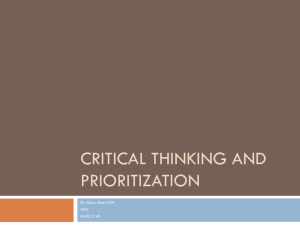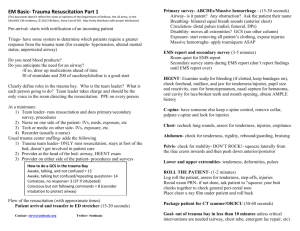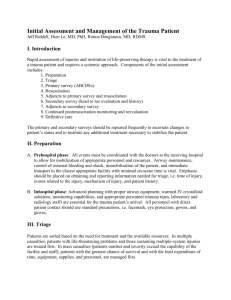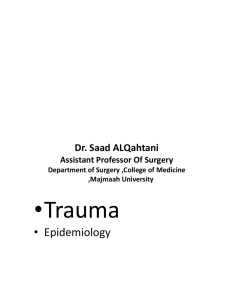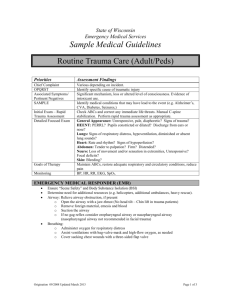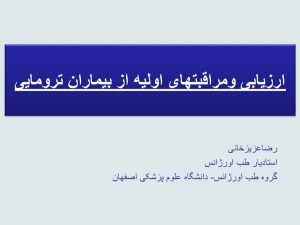Introduction to Trauma Care
advertisement
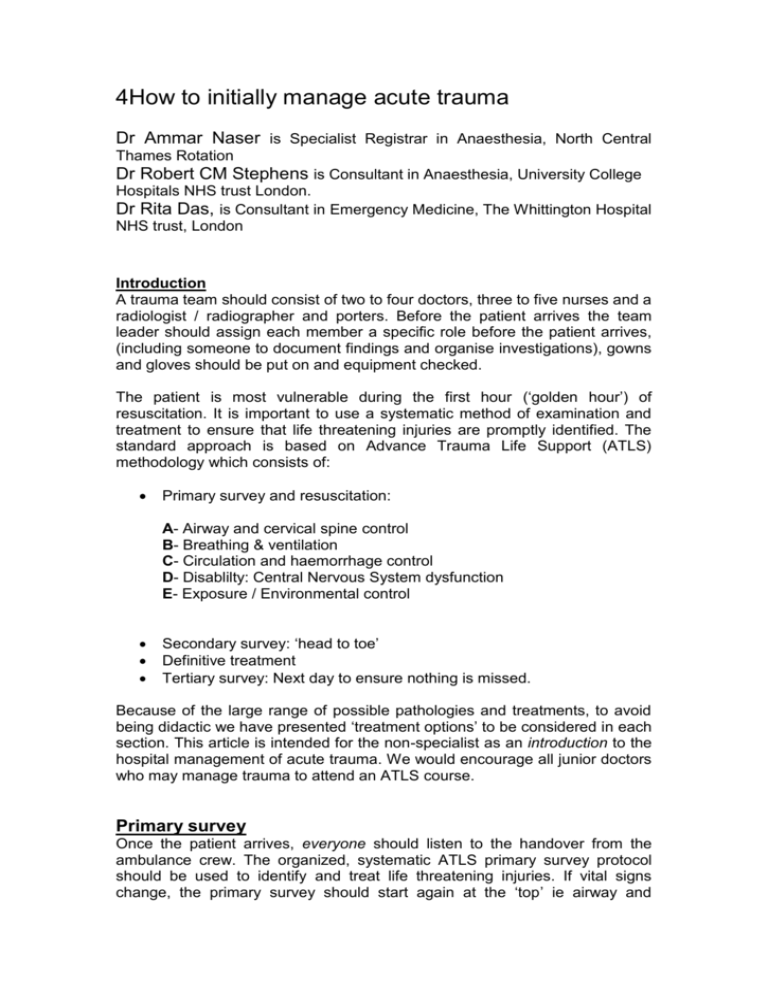
4How to initially manage acute trauma Dr Ammar Naser is Specialist Registrar in Anaesthesia, North Central Thames Rotation Dr Robert CM Stephens is Consultant in Anaesthesia, University College Hospitals NHS trust London. Dr Rita Das, is Consultant in Emergency Medicine, The Whittington Hospital NHS trust, London Introduction A trauma team should consist of two to four doctors, three to five nurses and a radiologist / radiographer and porters. Before the patient arrives the team leader should assign each member a specific role before the patient arrives, (including someone to document findings and organise investigations), gowns and gloves should be put on and equipment checked. The patient is most vulnerable during the first hour (‘golden hour’) of resuscitation. It is important to use a systematic method of examination and treatment to ensure that life threatening injuries are promptly identified. The standard approach is based on Advance Trauma Life Support (ATLS) methodology which consists of: Primary survey and resuscitation: A- Airway and cervical spine control B- Breathing & ventilation C- Circulation and haemorrhage control D- Disablilty: Central Nervous System dysfunction E- Exposure / Environmental control Secondary survey: ‘head to toe’ Definitive treatment Tertiary survey: Next day to ensure nothing is missed. Because of the large range of possible pathologies and treatments, to avoid being didactic we have presented ‘treatment options’ to be considered in each section. This article is intended for the non-specialist as an introduction to the hospital management of acute trauma. We would encourage all junior doctors who may manage trauma to attend an ATLS course. Primary survey Once the patient arrives, everyone should listen to the handover from the ambulance crew. The organized, systematic ATLS primary survey protocol should be used to identify and treat life threatening injuries. If vital signs change, the primary survey should start again at the ‘top’ ie airway and proceed down. In this way the team leader continuously re-evaluates his/her findings as patients may deteriorate or change rapidly. If the patient is on a spinal board or scoop for immobilisation, it must be removed using a ‘scoop to ski’ technique as prolonged use of this device can cause serious pressure sores. Airway management with cervical spine control The patient should receive high flow Oxygen. An anaesthetist should assess and manage the airway: if the patient can talk, the airway is likely to be clear can breath, and has cerebral perfusion. If they have a reduced conscious level the patient may not be able to maintain their airway. Soot in the airway, hoarseness, stridor, foreign bodies, blood and lacerations should alert you to impending airway problems. Assume cervical spine injury and maintain the spine in neutral position (hard collar, taped with sand bags wither side of the head) until proven otherwise clinically and radiologically. During intubation it is acceptable to remove the hard collar to aid jaw movement so long as someone performs ‘manual in line immobilisation’ of the head and neck. Airway management with cervical spine control treatment options include: O2 administration Basic airway manouvers: chin lift+ jaw thrust Oropharyngeal or nasopharyngeal airway- but caution with bleeding Endotracheal intubation Surgical airway ie Cricothyroid/Tracheostomy Breathing & Ventilation The chest must be examined by inspection, palpation, percussion and auscultation. Trachea position (central or displaced), neck vein distension, cyanosis, respiratory rate and pattern, breath sounds, O2 saturation, visible wounds / flail chest, surgical emphysema, and chest symmetry should be sought. Life threatening chest injuries such as tension pneumothorax, open pneumothorax, cardiac tamponade, flail chest and massive haemothorax must be identified and rapidly treated. Breathing treatment options include: Endotracheal intubation and ventilation Needle decompression Chest drain Pericardial drainage Thoracotomy Adequate analgesia Circulation and haemorrhage control Two intravenous cannulae (grey, 16g or bigger) should be inserted, and basic observations taken (blood pressure, heart rate, O2 saturation) on a regular basis. Tachycardia and/or hypotension after traumatic injury is assumed to be due to significant (>30% blood volume) blood loss until proven otherwise. Stopping haemorrhage with rapid haemostatic techniques (eg compression, bandage, pelvic splint, fracture reduction, interventional angiography or laparotomy) is the first priority in the treatment of traumatic haemorrhagic shock, with concomitant fluid resuscitation (fluid and blood) to maintain perfusion and organ function. One approach to in-hospital resuscitation for the treatment of trauma patients with haemorrhagic shock is the rapid infusion of two litres of crystalloid, However many experts advocate giving less and observing the response ie halt bleeding while maintaining adequate tissue perfusion: this is a controversial area. This may be followed by blood transfusion with blood (uncrossmatched blood ie O-negative, ABO type specific or fully crossmatched depending on urgency and availability) if there is evidence of ongoing hypovolaemia or anaemia. Fresh frozen plasma and cryoprecipitate should be considered early in massive haemorrhage. The resuscitation endpoints (how to tell if you have given enough) that have been evaluated include restoration of blood pressure, heart rate and urine output, capillary refill, lactate, base deficit, mixed venous oxygen saturation, and ventricular end-diastolic volume. Remember, patients can compensate for hypovolaemia (by vasoconstricting) and so delay the appearance of tachycardia and hypotension. Bleeding can occur externally or be from the thoracic, abdominal or pelvic cavities, long bones or spine. Diagnosis can be aided by ultrasound (eg ‘FAST’ scan: Focused Assessment with Sonography for Trauma), CT, X-ray, angiography, diagnostic peritoneal lavage and blood tests (FBC, U + E, blood gasses). System Sign Cardiovascular Increased heart rate Increased capillary refill time Decreased blood pressure (late sign) Decreased pulse pressure Cool and Clammy skin Respiratory Neurological Increased respiratory rate Confusion/ Agitation Other Decreased conscious level Decreased urine output Signs of hypovolaemia Circulation and haemorrhage control treatment options include: Warm fluids (crystalloid / colloid) Warm blood and blood products (eg Fresh Frozen Plasma), Arrest bleeding by direct local pressure Arrest bleeding by splinting pelvis Central line if inotropes / vasopressors are needed Urinary catheter Surgery (‘damage control’ or definitive) Disability: Dysfunction of the central nervous system A quick neurological assessment is an essential part of the primary survey. In general if the patient is talking appropriately he/she has clear airway, adequate ventilation and intact cerebral function. Of course this can change, hence the need for repeating the primary survey should deterioration occur. The Glasgow Coma Scale (GCS) can be used to give a reliable, repeatable and objective way of recording the conscious state of the patient. Always try to make an assessment before intubation as sedation interferes with consciousness. Record the three values separately (eg E3V3M5) as well as their sum are recorded. The lowest possible GCS (the sum) is 3 (deep coma), while the highest is 15 (fully awake person). A drop of 2 in the GCS usually requires investigation eg CT head. Glasgow Coma Score Best Eye Opening (E) Best Verbal Response (V) Best Motor Response (M) 4=Spontaneous 3=To voice 2=To pain 1=None 5=Normal conversation 4=Disoriented conversation 3=Words, but not coherent 2=No words......only sounds 1=None 6=Normal 5=Localizes to pain 4=Withdraws to pain 3=Decorticate posture 2=Decerebrate 1=None Disability treatment options include: O2 administration Intubation (to ensure normal p02 and pC02) Inotropes / vasopressors (to ensure adequate cerebral perfusion) Head up, ensure venous drainage Emergency imaging of brain or spine Neurosurgery Exposure / environmental control Fully undress the patient, allowing a thorough secondary survey. Avoid hypothermia which can have devastating consequences (coagulopathy, acidosis) by actively warming the patient. Check blood sugar. Initial Investigations: FBC, U+E, glucose, cross match, blood gas Chest and pelvis plain radiographs AP, Lateral and Odontoid peg view cervical spinal radiographs Secondary survey The secondary survey occurs after all life-threatening injuries from the primary survey have been identified and treated, and parallel initial investigations performed (see box). It aims to identify all the injuries sustained, involves a thorough head to toe examination including full neurological examination, examination of the spine, log rolling and performing a PR exam. Take a complete history from the patient, paramedics, police or relatives. Key questions stem from the mnemonic AMPLE “Allergies, Medication, Past medical history, Last meal (relevant for surgery), and Event and Environment related to injury”. As a result of the secondary survey further investigations may need to be taken. Definitive care Definitive care starts once the patient has been resuscitated and any life threatening injury dealt with. It includes further surgical intervention, antibiotics, tetanus immunisation and may involve transfer to a tertiary centre. Transferring a trauma patient is very risky and should involve the most appropriate doctor, trained in transfer. Ideally a tertiary survey should be performed the next day to ensure nothing has been missed in the initial surveys (eg small but functionally important digital injuries). Patients with certain injuries may sometimes need transfer before the secondary survey or even during the primary survey eg isolated head injury or polytrauma patients requiring cardiothoracic surgery. Summary: Trauma is a leading cause of death and disability especially amongst young people. A well rehearsed and systematic ‘ATLS’ approach to hospital resuscitation can save lives as well as limiting the consequences of the trauma. It should be remembered that the primary survey should be repeated whenever an intervention has been made and if changes in the patient’s clinical state occurs, to avoid the ‘triad of death’ (hypothermia, acidosis and coagulopathy) and to be aware of the golden first hour of trauma resuscitation: delays in treatment can kill.
